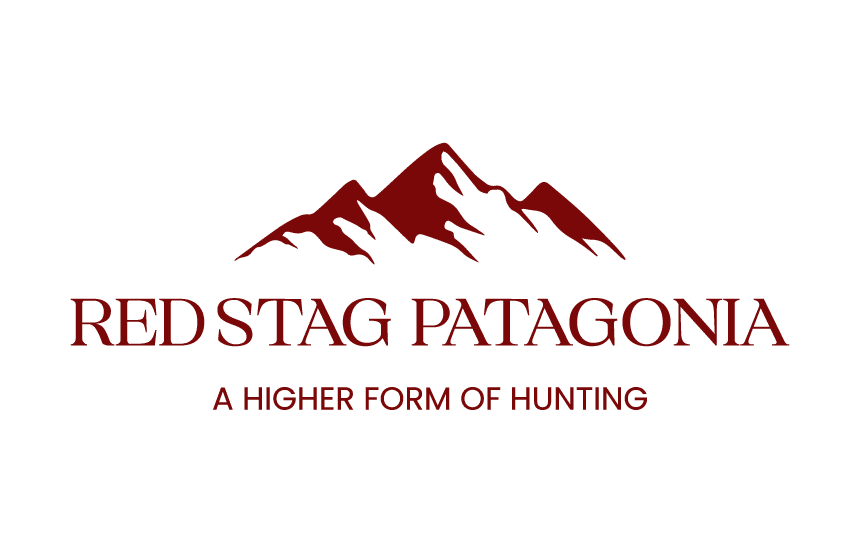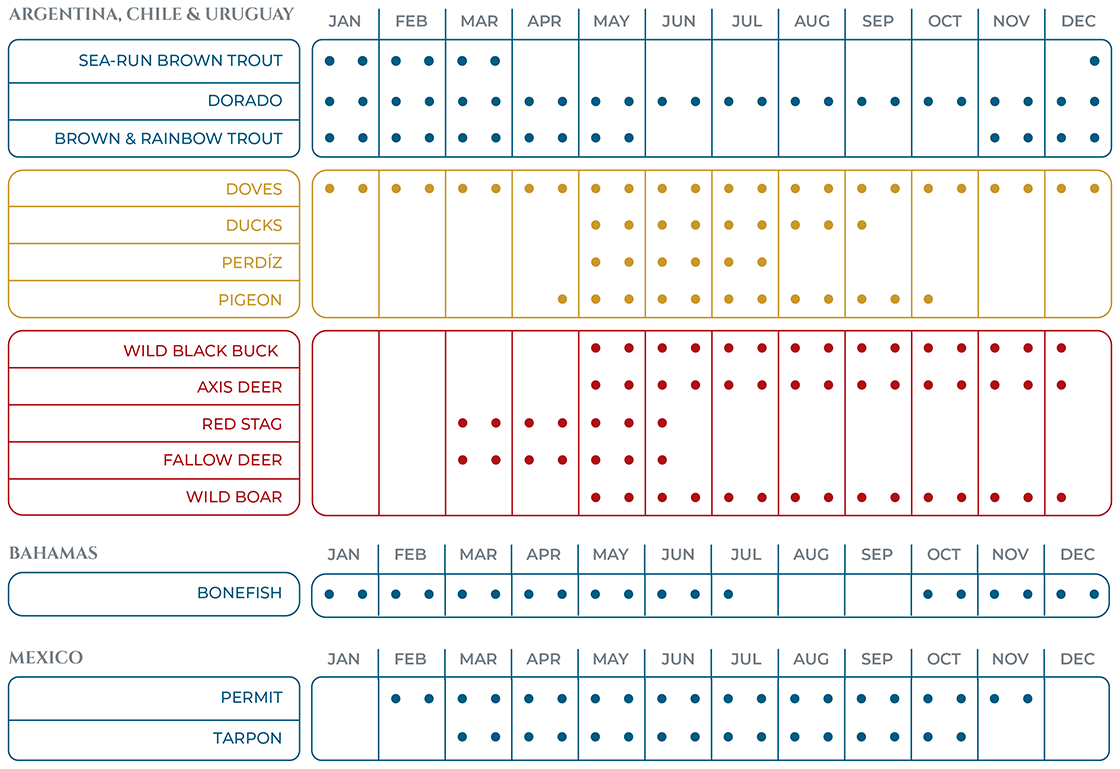What Time of the year should I come?
Villa María Lodge is situated in the lowest part of the Río Grande just a few hundred yards away from the tidal section of the river. This location impacts directly how the fish behave and how the fishing develops throughout our season. The regular fishing season on the Río Grande runs from November 1st until April 15th. As Villa María Lodge is situated in the lowest stretch of the Río Grande, the water level is the biggest factor affecting our fishing tactics, fly selections, and the behavior of the fish themselves. Every liter of water that enters the river system enters the estuary, meaning any water event, even in the highest reaches of the drainage can change our conditions. For instance, during a normal season, our section’s levels in November and December are higher and can become quite fast. This leads to the use of very heavy rod & line setups, including super-fast sinking lines and big flies. During high flows, we may also find the river uncross-able, preventing us from fishing the other bank. All this limits the possibilities and chances to properly fish the pools and catch fish. This phenomenon typically occurs again in April due to the melting of the early Andes snows and the autumn’s precipitations.
This is why Villa María Lodge opts to run their fishing season during January, February, and March ensuring our anglers find the river in optimal condition. During these months of stable flows we are able to use comfortable angling setups, and encounter safer wading situations. Freeing our guides and anglers to fish from both banks, in order to use pool-specific techniques and adjust for varying angler skill levels and wind levels. Considering all of the above, we typically look at the Villa Maria season as broken into three parts: January (opening), February (mid-season), and March (End of season).
January (opening)
At the beginning of January, you will find the river at a good level, with fair-to-good visibility. Most of the pools will have a consistent flow and speed from their head to the tail out. The water level typically decreases throughout the month and the water clarity will also improve accordingly. In January you will be fishing almost exclusively for sparkling fresh fish. Fish that just got into the river that same night and some that have been in the system just a few days. Medium-to-large chrome fish are the norm and we typically catch more egg-laden females than male sea trout. Sometimes at a ratio of 10-to-1. It’s not that the males are not there, but they are not aggressive enough to start taking flies. Most of the fish will be located in the heads of the pools and will be aggressive towards flies swinging by. Visually, this is a sight to behold. You will watch as fresh fish porpoise and rooster-tail into new pools and it’s not uncommon to see schools of fish running from pool to pool through the riffles.
During this month, especially in the first 3 weeks, the fish are very dynamic and they move very quickly upstream. A pool that was packed in the morning session can look pretty empty during the evening and pools that looked dead for a couple of sessions or even days can come to life fast as the fish stop, rest, and run through them. That’s why during this time, the guides move a lot and fish several pools during the fishing sessions and the action can take place anywhere at any moment.
January’s tactics are as dynamic as the fish stop and settle in different types of pools. You will fish deep classic bends that are beautiful holding pools and you will fish runs and shallows full of rocky structure. Most of the time you will be casting fast-to-super-fast sinking tips and medium-to-fast sinking shooting heads. But intermediate tips are gaining popularity rapidly as they are very nice to cast and they allow us to fish shallower pools and rocky places during windy days where a floating line can be pushed and dragged by the wind giving the fly an unwanted speed.
With regards to the flies, most of the time you will be fishing big rubber legged flies like those classic girdle bugs, yuk bugs, and the infinite derivations of those patterns. Streamers and leeches will also be thrown during the day. Some tube flies like Sunray Shadow are fantastic to use in shallower water attached to an intermediate line. Of course, these flies are not the only patterns that will catch fish. If the water conditions – and speed – is good enough you will start fishing with smaller nymphs, as well.
February (mid-season)
During February (and the end of January) the river keeps dropping, the pools start to flow slower, the water clears, and warms, as February is the warmest month of the year in Tierra del Fuego. All this leads us to wade and cast carefully, use lighter rods and lines, longer and thinner leaders and we also start using smaller flies. From the first cast of the day, the fish get more skittish, and starting with a heavy line with a big profile fly can be counterproductive most of the time.
In February, fresh fish keep coming in numbers riding each tide, especially the first two weeks of the month. We typically find a very healthy mix of fresh, chrome fish and their earlier-arriving cousins who have been in the system since late December and January. During February, the running fish are typically smaller. Of course, there are fresh sea trout running weighing in the high teens, but due to the lower level of the river, the bigger fish might find it too difficult to run up through the lower river’s shallows.
As the river gets lower, most of those shallower runs that we used to fish in January, are no longer good sections for holding, so the fish are found mainly in the holding pools, usually from top to bottom. During high sun hours, the fish might gather in the deepest parts of the pools, and as soon as the sun drops to the horizon, the fish spread out in the pools. This is when the “magic hour” takes place as the water gets cooler and the sunlight is not as harsh. You will keep using big streamers and leeches but mainly during the last half hour of the fishing day. Most days you will be using small rubber legs, nymphs, and big dry flies like Bombers and Green Machines.
March (end of season)
March starts by telling us that autumn is getting close. Winds drop significantly as the temperature does. We typically start experiencing rain showers and you may even spot some snow high in the Andes range. All this will contribute to a change in the river’s level and, as a consequence, the behavior of the fish. The main run of fish will be over but there will be pulses of fresh sea-trout arriving continuously, but in much smaller numbers than what we found in prior months. As the river rises compared to the driest season – late January and February – the fish will start to move upstream into the mid and upper section of the system and gather in numbers in places where they find the best spawning conditions.
The fishing techniques will change accordingly to the water’s temperature, especially in the last 2 or 3 weeks of March. Early in the morning and late evening, the activity will be slower than midday when water temperatures reach their maximum. If the water gets too cold, you might need to use heavier lines, bigger flies (usually in bright colors), and fish them slowly along the pools to tease the territorial male fish that start to spread out in the pools and fight for the best mates and spawning grounds. And this is the main attraction of this time of the season, those huge red, male sea trout that were lacking aggression for months, now start attacking flies giving epic fights, tons of adrenaline, and timeless photographs and memories. We usually are asked “when is the best time to come” and our answer is always the same “depends what do you like to do and how do you like fish”.







